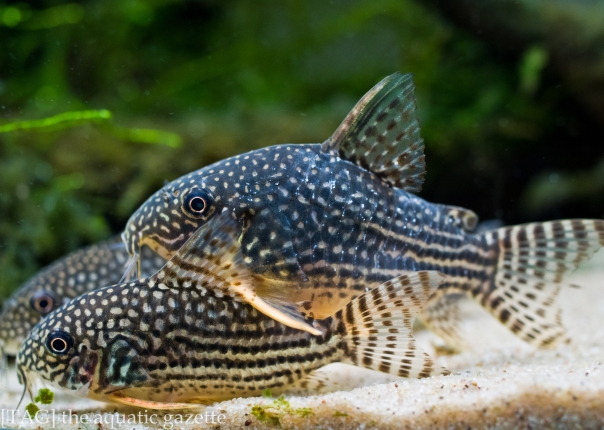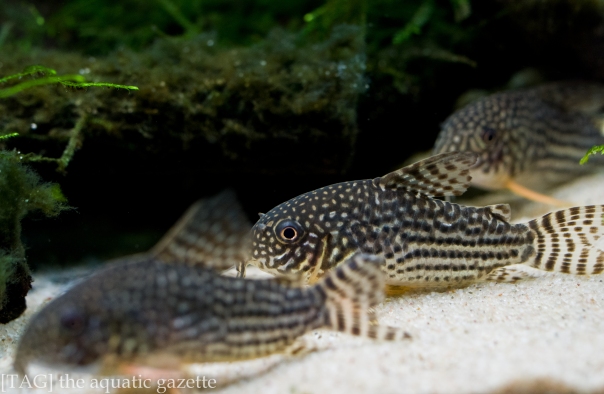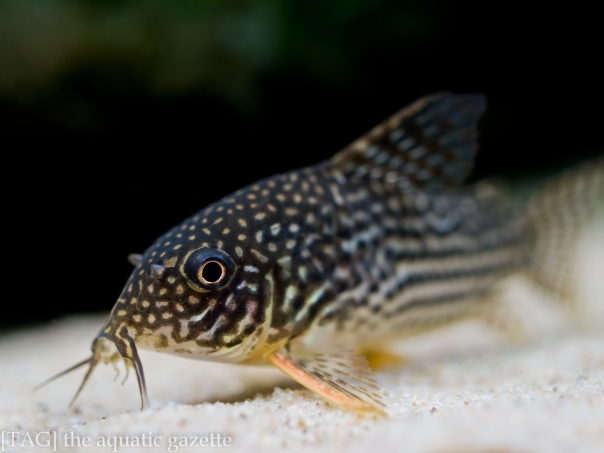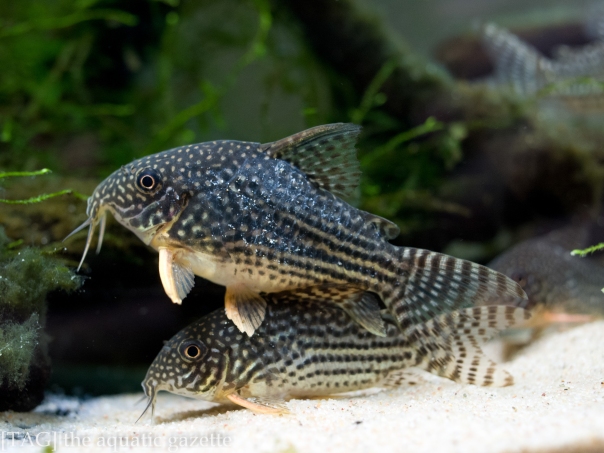The Corydoras sterbai is a popular catfish to keep, it is regularly recommended to new keepers because of its hardy properties, attractive markings, shoaling behaviour and small size. It was named after, and in honour of Dr Günther Sterba.
In the Wild
Wild C. sterbai originates from slow South American waters that are low in pH and oxygen. These waters are swallow and clear, which enables the C. sterbai to make quick dashes to the surface for air. Just like the Betta and Gourami, their ability to take air directly from the atmosphere helps them survive in areas where other fauna will perish from oxygen deficiency. Being bottom dwellers, they forage for food using their sensitive barbels for insects, fish parts and plant matter that have sunk to the bottom. In the wild, they are easily found in shoals of hundreds and sometimes in the thousands.
In the Aqauarium
Almost all of the C. sterbai found in our local fish shops today, are tank bred and this is a good thing. Tank bred C. sterbai are hardier than their wild counterparts as they have been brought up in an environment that is very similar to our aquariums. This similarity is what enables them to adapt readily to any well-maintained aquarium.
The C. sterbai thrive in a pH range of about 6.0 to 7.5 and the aquarium’s temperature should be kept between 24 to 28 degree Celsius. If possible, driftwood should be introduced to simulate their natural environment. They should be fed a sinking food type of good quality as their staple diet, Hikari’s Sinking Wafers are recommend. (http://theaquaticgazette.com/2011/04/29/hikari-sinking-wafers/)
As there are a very peaceful fauna that only grows to a maximum of 6.5cm, aggressive and larger tank mates should be avoided. In the wild, they shoal in large numbers and because of this genetic imprint, C. sterbai should not be kept in groups of less than 5 members. As it is with other shoaling fauna, the larger the group, the more stable the members are.
One common question we get from new Corydoras owners is what substrate should be used and what size should it be? Here at [TAG], we would recommend sand because of the following reasons.
1. Substrate cleanliness is a priority. Poor substrate health usually leads to the degradation or infection of the C. sterbai’s barbels. C. sterbai that have lost their use of their barbels will have difficulty hunting for food, with some infection cases leading to a growth over the mouth, completely blocking any access to food. Because sand is one of the most compact of substrates, this prevents uneaten food or dirt from slipping deep into the substrate, ensuring good substrate health. When using gravel which has a bigger grain size, regular maintenance is necessary to ensure dirt does not build up between the cracks.
2. When C. sterbai forages for food in a sand based substrate, they suck sand through their mouths and blow it out through their gills, filtering any food that is found. Through this act, it shows that the substrate in nature is small enough to allow this.
3. There has been some speculation that gravel can hurt the C. sterbai’s barbels if they have sharp edges. Although this is unproven at the moment, it is just another reason to use sand if you would not like to take the risk.
All three reasons are strong incentives to use sand. However sand is light and does move around quite a fair bit, and it can be a disaster if sucked into a filter as a filter’s impeller is sensitive. Any slight damage to the impeller may result in a noisy filter or reduced performance. As such, we would recommend the use of quality sand, such as ADA’s Rio Negro sand. Quality sand are usually softer and compact better, and even if sucked into a filter, they are soft enough to not do any damage. We would be doing a review on ADA’s Rio Negro sand in the near future.
Although the C. sterbai originates from slow moving waters that are low in oxygen, we would not encourage a replication of such an environment in your aquarium. As with any aquatic fauna, they will benefit from a moderate flow and good oxygen levels. A moderate flow (except for fauna that require a high flow) will keep dirt from accumulating, improve your fauna’s appetite and ensure a good gaseous exchange. As long as your C. sterbai can rest on the substrate or swim without getting blown around, your flow is fine. In our 15 litres C. sterbai tank, we have a flow rate of about 300 litres per hour, a turn over rate of 20 times per hour.
With good flow and good water surface agitation, a healthy amount of oxygen will be present in your aquarium. As this level is more than what is available in the wild, your C. sterbai should not need to dart to the surface and take in air very often. If it happens once in a while, don’t be alarmed and take it to mean that your oxygen levels are low, it is a reflex that is part of their genetic imprint. But if it happens often, it is then likely that your aquarium suffers from low oxygen levels.
The C. sterbai is a good start to any new Corydoras keeper, and a fine addition to an established one. New keepers will be especially won over by their family behaviours and the bonds that they form within themselves. We hope that you enjoy keeping these heart warming fauna, as much as we have.
[TAG]






